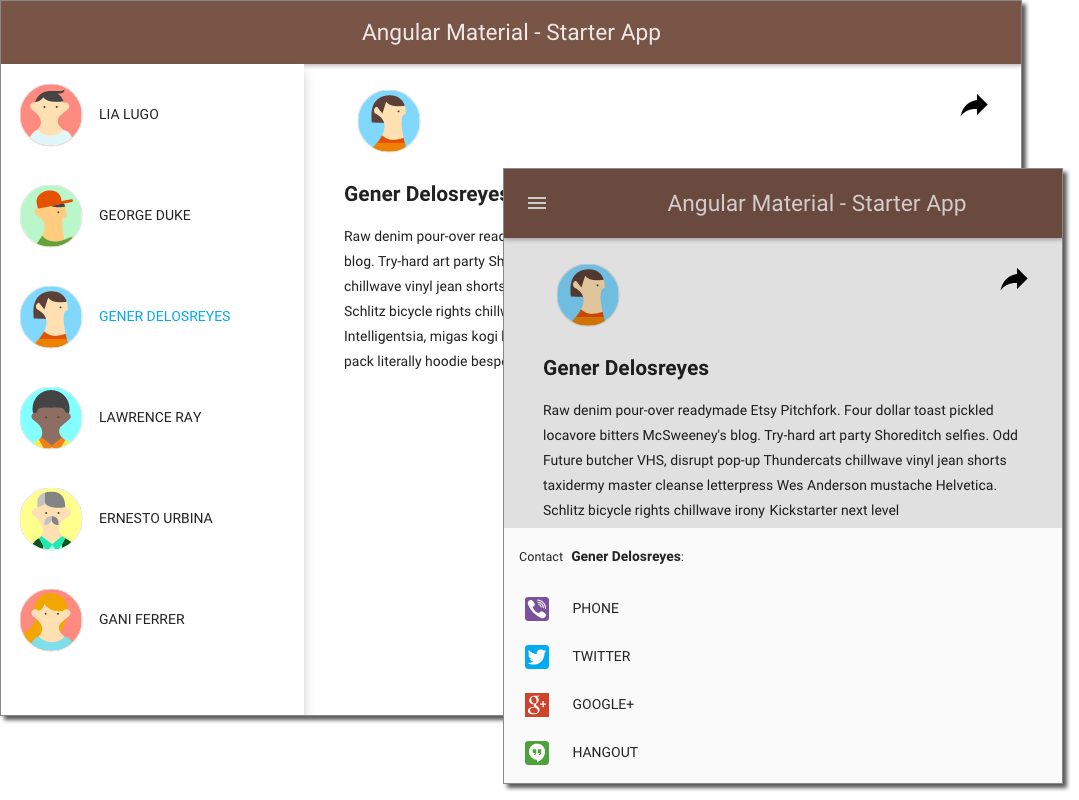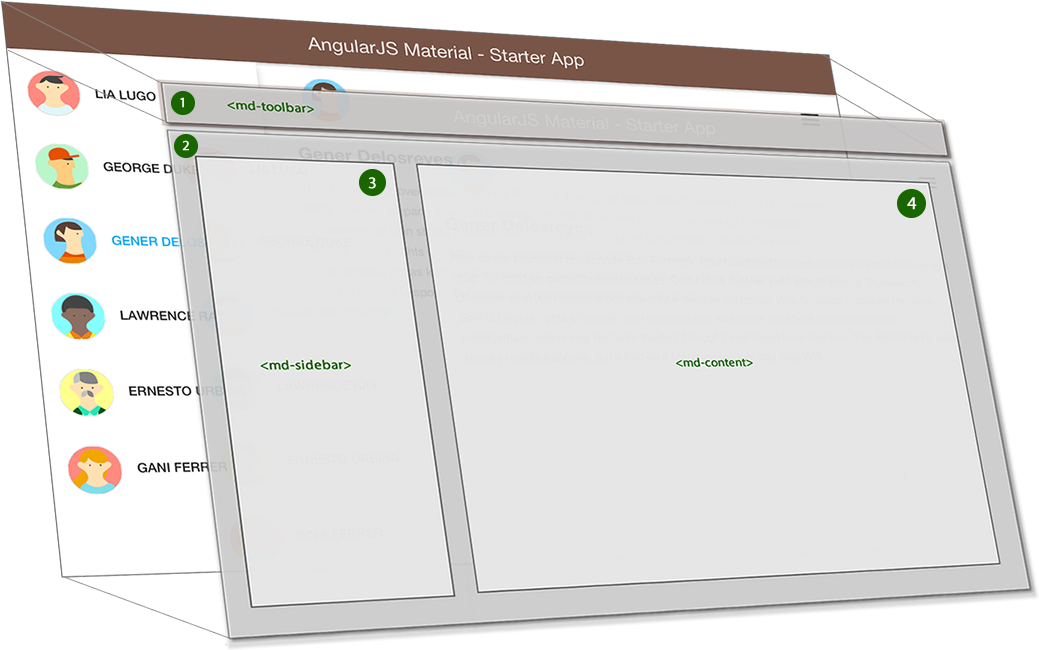This Material start project is a seed for AngularJS Material applications. The project contains a sample AngularJS application and is pre-configured to install the Angular framework and a bunch of development and testing tools for instant web development gratification.
This sample application is intended to be useful as both a learning tool and a skeleton application for a typical AngularJS Material web app: comprised of a Side navigation area and a content area. You can use it to quickly bootstrap your AngularJS webapp projects and dev environment for these projects.
Below is a snapshot of the Starter-App with the Users' master-detail view. Also shown is the user experience that will be displayed for smaller device sizes. The responsive layout changes to hide the user list, reveal the menu button. In the User Details view, you may also click the share button to show the Contact <User> bottom sheet view.
This Starter app demonstrates how:
- Angular Material
layoutandflexoptions can easily configure HTML containers - Angular Material components
<md-toolbar>,<md-sidenav>,<md-icon>can be quickly used - Custom controllers can use and show
<md-bottomsheet>with HTML templates - Custom controller can easily, programmatically open & close the SideNav component.
- Responsive breakpoints and
$mdMediaare used - Theming can be altered/configured using
$mdThemingProvider - ARIA features are supported by Angular Material and warnings can be used to improve accessibility.
This repository contains two ES5 branches:
es5-tutorials- Step-by-step instructions that clearly demonstrate how the Starter application can be created in minutes.es5(this branch) - The final ES5 version which you complete in the last step of the tutorials above.
These ES5 tutorials were presented live, on-stage at ng-conf 2015, Utah.
You will need git to clone the material-start repository. You can get git from http://git-scm.com/.
We also use a number of node.js tools to initialize and test material-start. You must have node.js and its package manager (npm) installed. You can get them from http://nodejs.org/.
To get you started, first, clone the Material-Start repository using git:
git clone https://github.com/angular/material-start
cd material-start
Next, checkout the es5 or es5-tutorial branches.
git checkout es5
Note: The
masterbranch contains the es6 version of this project.
We have two kinds of dependencies in this project: tools and AngularJS framework code. The tools help us manage and test the application.
- We get the tools we depend upon via
npm, the node package manager. - We also get the AngularJS and Angular Material library code via
npm
npm install
You should find that you have one new folder in your project:
node_modules- contains the npm packages for the tools we need
app/ --> all of the source files for the application
assets/app.css --> default stylesheet
src/ --> all app specific modules
users/ --> package for user features
index.html --> app layout file (the main html template file of the app)
While AngularJS is client-side-only technology and it is possible to create AngularJS web apps that
don't require a backend server at all, we recommend serving the project files using a local web
server during development to avoid issues with security restrictions (sandbox) in browsers. The
sandbox implementation varies between browsers, but quite often prevents things like cookies, xhr,
etc to function properly when an html page is opened via the file:// scheme instead of http://.
The angular-material project comes pre-configured with a local development web server. It is a node.js tool called live-server.
You can run the following command to start the server:
node ./node_modules/live-server/live-server.js . --open=app
This should open your browser to http://localhost:8080/app/ so you can view the Material-Start app.
You can install also live-server globally to make life easier and for use with other applications:
npm install -g live-server
Then you can start your own development web server to serve static files from a folder by running:
cd my-project
live-server .
Finally, you can choose to configure your a different webserver, such as apache or nginx. Just
configure your server to serve the files under the app/ directory.
Previously we recommended that you merge in changes to angular-seed into your own fork of the project. Now that the AngularJS framework library code and tools are acquired through package managers (npm) you can use these tools instead to update the dependencies.
You can update the tool dependencies by running:
npm update
This will find the latest versions that match the version ranges specified in the package.json file.
For more information on AngularJS please check out http://angularjs.org/
For more information on Angular Material, check out https://material.angularjs.org/

